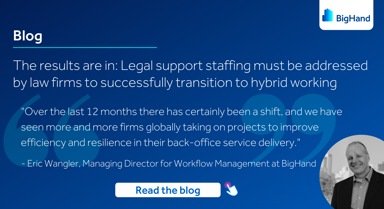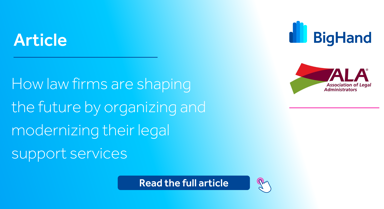In our latest in-depth market research, we explore the trends, concerns, and potential solutions to mitigate staff attrition while containing costs and delivering the level of service expected by clients. The mass staff exodus continues to pose a significant challenge for law firms, and this trend is expected to intensify. Research shows 53% of firms have reported an increase in support staff attrition over the past year. For those in North America this is even more significant, as 60% of firms have seen an increase in support staff attrition.
The data shows that over the past five years, managing staffing situations has become increasingly more complex. With the looming fear of recession, inflation, and additional cost pressures, law firms must embrace new ways of thinking. It is evident that the landscape of the legal industry will never revert to its previous state, necessitating innovative strategies to address staff attrition.
Short-term quick fixes lack longevity and firms need to plan for sustainable growth. It’s imperative firms introduce actionable steps to help manage attrition and control costs while meeting service expectations. To help facilitate this, law firms need to develop a comprehensive five-year plan.
Here are key considerations to include in the plan:
- Establishing Support Structures
One of the first steps in combating staff attrition is to establish and continually evolve support structures within the law firm. Efficient task delegation, seamless communication, and effective collaboration are key aspects that foster employee satisfaction and engagement. To achieve this, law firms may benefit from having dedicated change agents or external consultants to help guide them on this journey of transformation.
By ensuring that responsibilities are well-distributed and communication channels are streamlined, staff members feel more supported in their roles, leading to improved job satisfaction and reduced turnover. To keep this measurable, firms can introduce internal staff surveys or other employee feedback channels so staff can voice their satisfaction or concerns over how much support they receive. This feedback can then be considered for areas of improvements.
- Adopting Modern Support Models
The second step involves adopting modern support models to address attrition challenges effectively. One such model gaining traction in the industry is the resource center approach. This approach involves transitioning associates from a direct relationship model to a centralized resource center.
Administrative tasks can be delegated to lower-cost support staff, freeing up high-cost resources for more substantive legal work. This not only reduces operational costs but also helps retain valuable legal talent by allowing them to focus on their core expertise. The report shows the vast majority (87%) of firms confirming clients have become far more business savvy when buying legal services over the past 12 months. To respond to this firms, need to use the most effective resource and have the right staff working on the right tasks, at the right time. Firms need digital support through Workflow technology to have visibility in what tasks staff are working on, and if the right tasks are being conducted by the most suitable resource.
- Engaging Stakeholders for Smooth Transitions:
Change management is never a straightforward process, especially in an industry as traditional as law. Engaging stakeholders throughout the organization is crucial for the successful implementation of any new processes or strategies. Involving staff and fee earners at all levels of the firm ensures that their voices are heard, and their valuable insights are considered.
As mentioned previously, by establishing clear communication channels and regular feedback mechanisms, law firms foster a culture of openness and inclusivity. This not only helps in reducing resistance to change but also strengthens the bond between employees and the firm, leading to improved loyalty and retention.
- Balancing Competitive Salaries with Work-Life Balance:
Offering competitive salaries has long been a go-to strategy for attracting and retaining top talent. However, as the job market evolves, work-life balance has emerged as a critical factor in support staff retention and recruiting. The key word here is retention. The report shows that over a third (38%) of respondents believe the estimated total cost of replacing support staff is $10,000 - $40,000, almost as many (32%) think the cost reaches $40,000 - $80,000. A further 15% put the cost over $80,000. Firms need to incentivize support staff retention through benefit packages, as the alternative could be costly.
To stay competitive in this regard, law firms must adapt to the changing times and adopt hybrid work models. Providing the flexibility of remote and in-office work can greatly contribute to employee satisfaction and retention.
To conclude, the legal industry is facing unprecedented challenges, and staff attrition is a significant concern for law firms worldwide. However, by adopting a strategic and comprehensive 5-year plan, firms can proactively tackle this issue and maintain exceptional performance standards.
By evolving support structures, embracing modern support models, engaging stakeholders, prioritizing work-life balance, and nurturing talent from within, law firms can create a work environment that attracts, retains staff, and ensures the correct resource is going to the right person. With these innovative strategies, law firms can thrive even in the face of increased staff attrition and continue to deliver the exceptional level of service lawyers have come to expect.
Together, we can navigate the complexities of attrition and build a stronger and more resilient legal industry for the future.
For more information on BigHand's research and to access the report, click here or contact [email protected].






